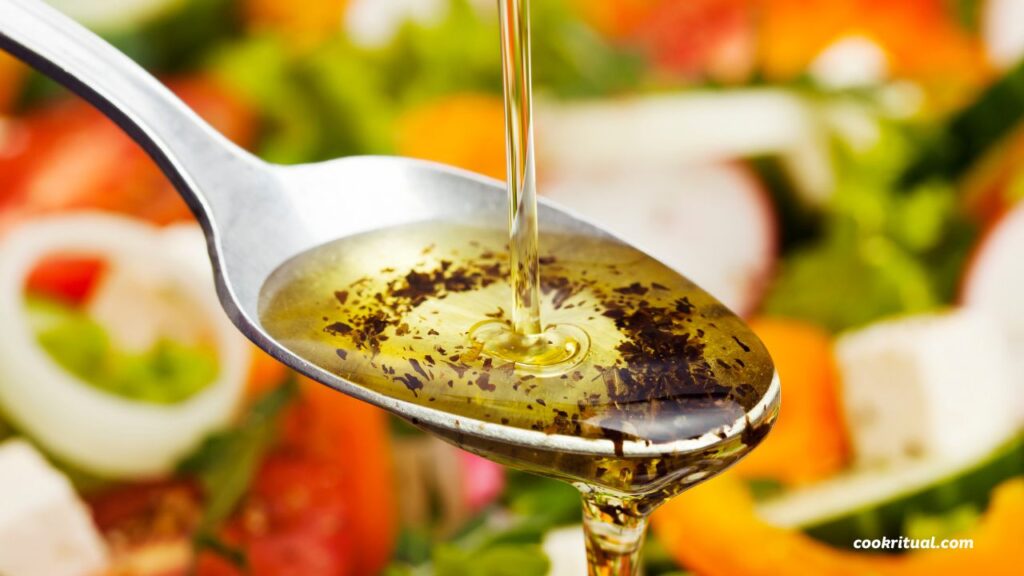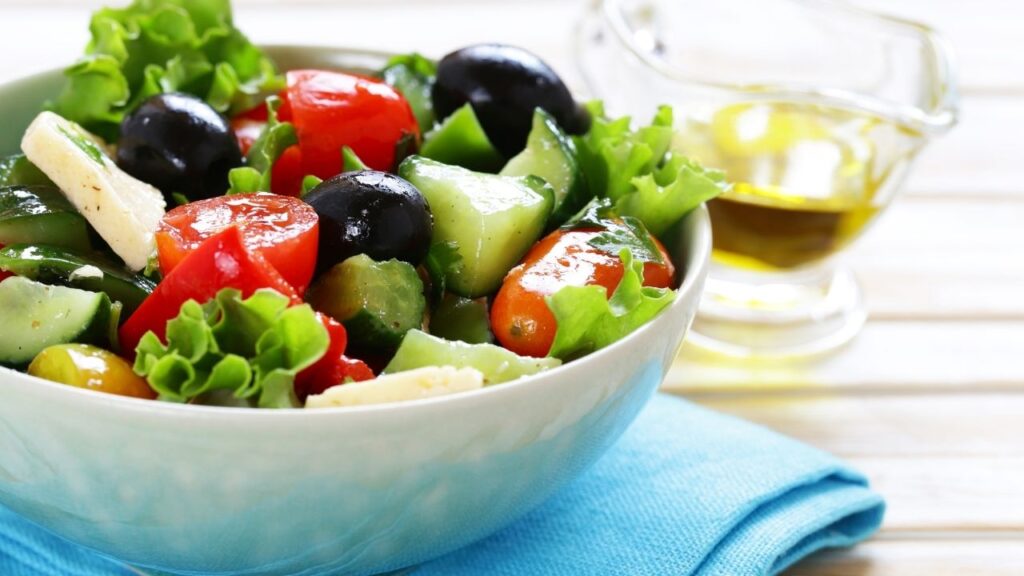Making your own salad dressings with olive oil is one of the easiest and healthiest ways to elevate any meal—while ditching preservatives, added sugars, and artificial flavors found in store-bought bottles. Whether you’re following a Mediterranean-style diet or simply want more control over what goes into your food, olive oil-based dressings are a flavorful, heart-smart choice that fits into any busy lifestyle.
We’ve all been there—standing in the grocery aisle overwhelmed by endless dressing options, unsure which is truly healthy. The good news? With just a few pantry staples like olive oil, vinegar, and your favorite herbs, anyone can whip up fresh, restaurant-quality dressings at home in minutes.
In this guide, we’ll walk through everything you need to know to confidently create your own olive oil dressings—from health benefits and essential ingredients to foolproof recipes and pro kitchen tips. You’ll learn how to customize dressings for your dietary needs, avoid common mistakes, and discover which olive oils work best for flavor and nutrition. Whether you’re meal prepping for the week or throwing together a quick lunch, these recipes and techniques will become your go-to kitchen staples.
Contents
- 1 1. Why Use Olive Oil for Salad Dressings?
- 2 2. Key Ingredients for Olive Oil Salad Dressings
- 3 3. Step-by-Step Guide: How to Make Salad Dressing with Olive Oil
- 4 4. Tips for Perfecting Your Homemade Dressings
- 5 5. Olive Oil Salad Dressing Recipes for Specific Diets
- 6 6. Buying Guide: Choosing the Best Olive Oil for Dressings
- 7 7. Comparing Store-Bought vs. Homemade Dressings
- 8 8. Common Mistakes to Avoid
- 9 9. Frequently Asked Questions (FAQs)
- 10 10. Final Tips & Delicious Pairings
- 11 Conclusion: Start Making Your Own Healthy Olive Oil Dressings
1. Why Use Olive Oil for Salad Dressings?

The Health Benefits of Olive Oil
Olive oil, especially extra virgin olive oil, is one of the healthiest fats we can eat. It’s packed with monounsaturated fats and antioxidants that support heart health and reduce inflammation. According to Harvard Health, regular use of olive oil may help lower the risk of heart disease and stroke.
Other health benefits include:
- Supports brain health and memory
- Aids digestion and reduces bloating
- May help control blood sugar levels
And because it’s natural and unrefined, extra virgin olive oil is a cleaner, more wholesome choice than many commercial oils or dressings filled with additives.
Types of Olive Oil for Dressings
There are a few types of olive oil you’ll see in stores, but not all are equal in flavor or nutrition. Here’s a quick guide:
| Type of Olive Oil | Best Use | Flavor | Nutrition |
| Extra Virgin Olive Oil | Dressings, dips, cold dishes | Rich, peppery, bold | High in antioxidants and vitamins |
| Virgin Olive Oil | Light cooking, marinades | Milder, less intense | Slightly less nutritious |
| Light Olive Oil | Baking or high-heat cooking | Very neutral | Heavily processed, fewer benefits |
For salad dressings, extra virgin olive oil is the best pick. It adds deep flavor and gives you the most health perks.
2. Key Ingredients for Olive Oil Salad Dressings
Must-Have Ingredients
While olive oil is the star, a great salad dressing comes to life with the right mix of flavors. These are our go-to ingredients:
- Vinegars – Balsamic, red wine, apple cider vinegar, or rice vinegar
- Citrus juice – Lemon, lime, or orange for brightness
- Mustard – Dijon or stone-ground to help emulsify
- Sweeteners – Honey, maple syrup, or agave for balance
- Herbs & spices – Garlic, shallots, oregano, basil, pepper
- Salt – Sea salt or kosher salt enhances everything
These basics let us mix and match depending on the salad or season.
Understanding the Olive Oil to Vinegar Ratio
A good dressing has a balance of fat and acid. The classic ratio is:
3 parts olive oil : 1 part vinegar
But that’s just a starting point. Here’s how to adjust:
| Taste Preference | Ratio (Oil : Vinegar) | Notes |
| Balanced (classic) | 3:1 | Smooth, not too sharp |
| Tangier (zesty flavor) | 2:1 | Great for strong greens like arugula |
| Milder acid (lighter taste) | 4:1 | Ideal for fruit-based or creamy dressings |
Adjust the ratio to suit your taste and the ingredients in your salad.
3. Step-by-Step Guide: How to Make Salad Dressing with Olive Oil

Let’s make it simple! Here are four classic olive oil dressings you can make in minutes.
Basic Vinaigrette Recipe (Lemon Garlic)
Ingredients:
- 3 tbsp extra virgin olive oil
- 1 tbsp fresh lemon juice
- 1 tsp Dijon mustard
- 1 clove garlic, minced
- Salt and pepper to taste
Instructions:
- Add all ingredients to a mason jar or small bowl.
- Shake well or whisk until smooth.
- Taste and adjust seasoning.
Pairs well with: mixed greens, quinoa bowls, grilled chicken
Creamy Olive Oil-Based Dressing (Greek Yogurt & Herb)
Ingredients:
- 3 tbsp olive oil
- 2 tbsp plain Greek yogurt
- 1 tbsp apple cider vinegar
- 1 tsp honey
- 1 tsp dried dill or parsley
- Salt and pepper
Instructions:
- Whisk yogurt and vinegar first.
- Slowly drizzle in olive oil while whisking to emulsify.
- Stir in herbs, salt, and pepper.
Great for: chopped salads, kale, or roasted veggies
Balsamic Vinaigrette (Classic Mediterranean Style)
Ingredients:
- 3 tbsp olive oil
- 1 tbsp balsamic vinegar
- 1 tsp Dijon mustard
- 1 tsp maple syrup or honey
- Salt and black pepper
Instructions:
- Combine all ingredients in a jar.
- Shake vigorously until creamy.
- Let sit 5 minutes before serving.
Best with: spinach, goat cheese, strawberries, walnuts
Citrus-Honey Dressing (Sweet & Tangy)
Ingredients:
- 3 tbsp olive oil
- 1 tbsp orange juice
- 1 tbsp lemon juice
- 1 tsp honey
- Pinch of sea salt
Instructions:
- Mix juices and honey in a bowl.
- Slowly add olive oil while whisking.
- Season with salt.
Lovely on: fruit salads, grilled shrimp, or arugula
These dressings are flexible. Try subbing in lime juice, tahini, or avocado for a fun twist. And remember, homemade dressings don’t just taste better—they’re better for you too.
4. Tips for Perfecting Your Homemade Dressings
Emulsifying Techniques
A smooth dressing starts with emulsification—mixing oil and vinegar so they don’t separate. There are a few easy ways to do this:
- Whisk it: Use a small bowl and a fork or whisk. Add oil slowly while whisking.
- Shake it: Put ingredients in a jar, tighten the lid, and shake hard.
- Blend it: Use a hand blender for a thick and creamy texture.
Mustard and honey help oil and vinegar stick together. They act as natural emulsifiers.
How to Store Homemade Salad Dressings
Homemade dressings are fresh, but they don’t last as long as store-bought ones. Follow these tips to keep them safe:
- Store in a clean glass jar with a tight lid.
- Keep them in the fridge, away from heat or light.
- Shake before each use.
Most olive oil dressings last about 5 to 7 days in the fridge. If it smells off or separates too much, toss it.
| Dressing Type | Shelf Life (Fridge) | Storage Tip |
| Basic vinaigrette | 7–10 days | Use olive oil and vinegar only |
| With fresh garlic/onion | 3–5 days | Use quickly to avoid spoilage |
| Creamy yogurt-based | 4–6 days | Keep extra cold and sealed |
USDA guidelines say to refrigerate homemade dressings made with dairy or fresh produce to prevent bacteria growth.
▸ Customization Ideas
Once you know the basics, it’s fun to experiment. Here are some ideas:
- Add avocado for creaminess
- Use tahini or nut butters for richness
- Try fresh herbs like basil, dill, or cilantro
- Add a pinch of crushed red pepper for heat
- Use flavored vinegars like raspberry or champagne
Dressings are easy to adjust. Taste as you go and keep it simple!
5. Olive Oil Salad Dressing Recipes for Specific Diets

▸ Keto-Friendly Olive Oil Dressings
For keto, skip the sugar and stick to high-fat, low-carb ingredients. Try this combo:
- 3 tbsp olive oil
- 1 tbsp apple cider vinegar
- 1 tsp mustard
- Salt, pepper, and herbs
Add MCT oil or avocado oil for extra fat.
Learn more about keto-friendly oils and dressings at Healthline.
▸ Vegan Salad Dressing Recipes
To make it vegan, avoid honey and dairy. Here’s a quick plant-based recipe:
- 3 tbsp olive oil
- 1 tbsp red wine vinegar
- 1 tsp maple syrup
- 1 tsp mustard
- Garlic, salt, and pepper
Use nutritional yeast for a cheesy flavor boost!
▸ Mediterranean Diet Dressings
Olive oil is a top choice for the Mediterranean diet. Combine:
- 3 tbsp olive oil
- 1 tbsp lemon juice
- 1 tsp oregano
- Pinch of sea salt
This works great with tomatoes, cucumbers, and feta.
6. Buying Guide: Choosing the Best Olive Oil for Dressings
▸ What to Look For on Labels
To get the best quality, check for these on the bottle:
- Extra virgin – Cold-pressed, pure, unrefined
- Harvest date – Fresher oils taste better
- Dark glass bottle – Protects oil from light
Avoid oils labeled “light” or “pure,” as these are often refined and lower in nutrients.
Learn more from the North American Olive Oil Association (NAOOA).
▸ Best Brands for Flavor and Quality
Here are a few trusted brands that balance taste and value:
| Brand | Type | Why We Like It |
| California Olive Ranch | Extra virgin | Fresh, fruity, and widely available |
| Lucini | Organic extra virgin | Bold taste, perfect for dressings |
| Kirkland (Costco) | Cold-pressed EVOO | Budget-friendly, good quality |
| Colavita | Mediterranean blend | Smooth and versatile for many uses |
Look for oils that are certified by NAOOA or COOC (California Olive Oil Council) for added trust.
▸ Storing Olive Oil for Freshness
To keep olive oil tasting great:
- Store in a cool, dark place
- Keep the cap sealed tightly
- Use within 6 months of opening
Avoid heat, light, and air. These can make oil go rancid. For best results, buy smaller bottles more often.
7. Comparing Store-Bought vs. Homemade Dressings
▸ Ingredient Transparency
When we make our own dressings, we know exactly what’s inside. There are no fillers, preservatives, or added sugars. Many store-bought dressings, even “healthy” ones, contain:
- Processed oils (like soybean or canola oil)
- High-fructose corn syrup
- Artificial flavors or colors
- Thickeners or emulsifiers
Reading food labels is important. The Mayo Clinic recommends choosing products with ingredients we can pronounce and recognize.
▸ Cost and Freshness Comparison
Homemade dressings are not only healthier, but often cheaper in the long run. Here’s a side-by-side comparison:
| Factor | Store-Bought Dressing | Homemade Dressing |
| Price (per 8 oz) | $3–$7+ | Around $1.50–$3 (depending on oil) |
| Shelf life | Up to 6 months | 5–10 days (fresh, fewer additives) |
| Customization | Limited | Unlimited flavor options |
| Ingredient control | Low | High (you choose everything) |
If we’re trying to eat cleaner and save money, homemade is the clear winner.
8. Common Mistakes to Avoid
Even simple dressings can go wrong. Here are common missteps—and how to fix them:
▸ Using Low-Quality Olive Oil
Low-grade oil leads to bland or greasy dressings. Always choose extra virgin olive oil for the best taste and nutrition.
▸ Getting the Oil-to-Vinegar Ratio Wrong
Too much vinegar makes it sour; too much oil makes it flat. Start with the 3:1 ratio and adjust from there.
▸ Not Emulsifying Properly
Oil and vinegar separate fast without help. Use mustard, honey, or garlic to bind everything together.
▸ Overpowering the Greens
Delicate greens like butter lettuce need lighter dressings. Heartier greens like kale can handle bold flavors. Match dressing strength to the salad base.
▸ Skipping the Taste Test
Always taste your dressing before pouring. Add a pinch of salt, a splash of acid, or a dash of sweetness to bring it to life.
9. Frequently Asked Questions (FAQs)
▸ Can I use olive oil straight on salad without mixing?
Yes, but it may taste flat. Adding acid (like vinegar or lemon juice) brightens the flavor and helps coat the greens better.
▸ What’s the healthiest vinegar for dressings?
Apple cider vinegar is popular for its gut-friendly enzymes. Balsamic is rich and slightly sweet. All vinegar types offer benefits—just avoid ones with added sugars.
▸ How long does olive oil dressing last in the fridge?
Basic vinaigrettes last up to 10 days. Dressings with garlic or dairy should be used within 3–5 days. Always store in a sealed container.
▸ Is olive oil safe for all diets?
Yes, it fits keto, vegan, Mediterranean, and gluten-free diets. It’s also approved by the American Heart Association—just use it in moderation.
10. Final Tips & Delicious Pairings
To make the most of your olive oil dressings, try these ideas:
- Dress just before serving to keep salads crisp
- Massage kale with dressing to soften it
- Drizzle over roasted veggies or grain bowls for extra flavor
- Use as a dip for bread or raw veggies
Great pairings:
| Dressing Type | Best Salad Match |
| Lemon garlic vinaigrette | Arugula, chickpeas, shaved parmesan |
| Balsamic vinaigrette | Spinach, strawberries, goat cheese |
| Creamy yogurt-herb | Romaine, cucumber, grilled chicken |
| Citrus-honey | Baby greens, oranges, almonds |
Conclusion: Start Making Your Own Healthy Olive Oil Dressings
Making salad dressings with olive oil is one of the easiest ways to eat healthier without giving up flavor. With a few simple ingredients, we can whip up fresh, delicious dressings in minutes—and skip the processed stuff in store bottles.
Olive oil delivers amazing health benefits, from heart health to better digestion. By combining it with the right acids, herbs, and seasonings, we get endless combinations that fit every taste and diet.
So let’s stock the pantry, grab a mason jar, and start mixing. Our salads—and our bodies—will thank us.


